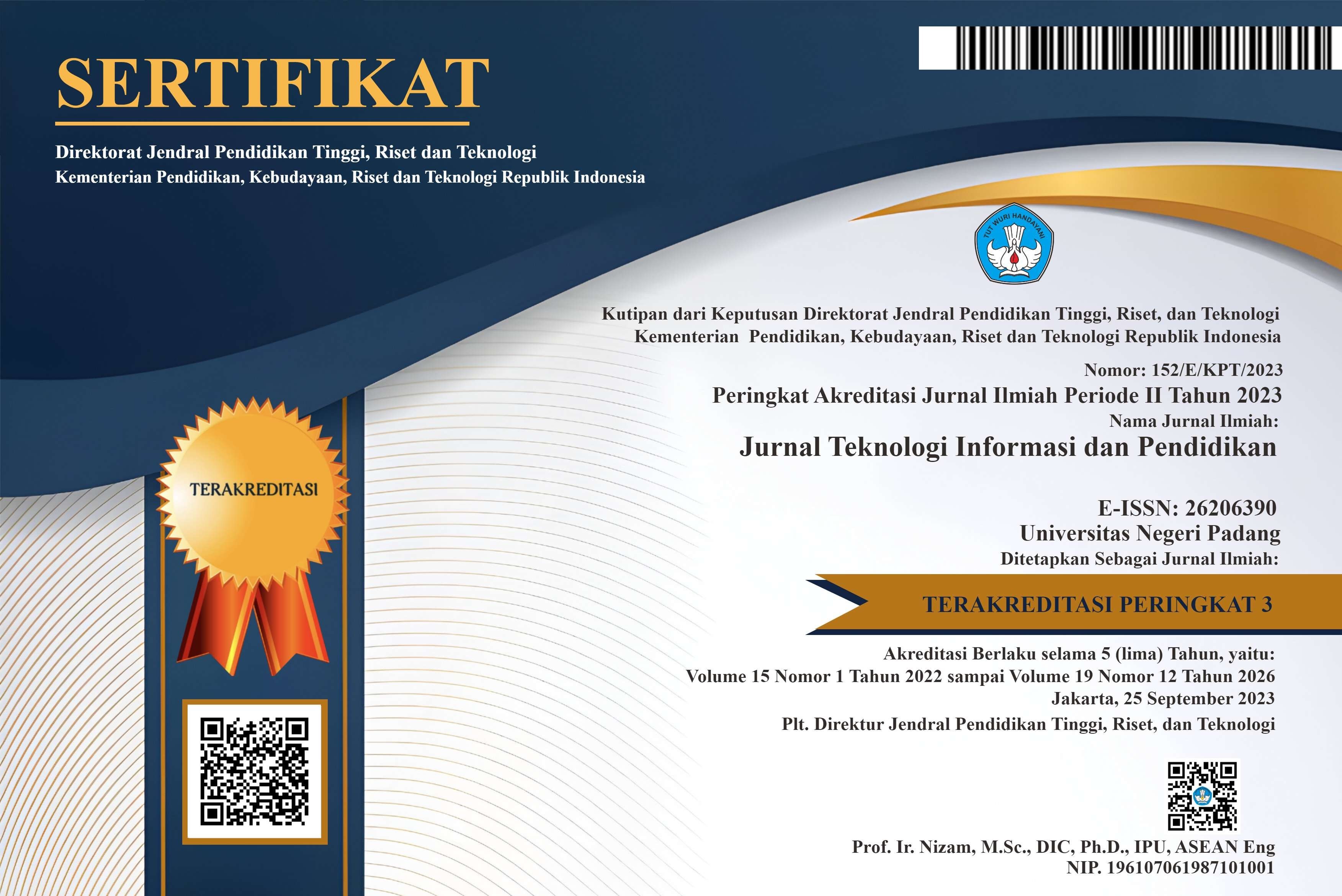Task Technology Fit Adoption in the Recruitment Process Using Google Form for IPSM Members
Abstract
The IT role that is likely to have the greatest effect on human resource processes is that of electronic forms processing transactions. recruitment through this portal is more intended to recruit indirect labor employees or employees who are not directly related to production and with a limited number. Therefore, many companies/organizations use Google Forms for the employee recruitment process which requires a large number of candidates. The purpose of this study is to empirically examine the effect of Task Characteristics, Technology Characteristics, and Individual Characteristics on Task Technology Fit and its influence on Individual Performance, User Satisfaction, Benefit, Utilization, Perceived Ease of Use, and Perceived Usefulness in the recruitment process using the google form. This research is quantitative research that will examine the effect of the variables, namely the independent variable and the dependent variable by testing the hypothesis. The population in this study was 219 members of the Association of Human Resource Practitioners (IPSM). The sample used in this study was 71 respondents who processed data using Smart PLS 3.2.9. The results of this study indicate that 8 of the 9 hypotheses show a significant and positive effect. This shows that IPSM members have adopted Task Technology Fit in their recruitment process by using the Google form. However, it is necessary to conduct further research with more respondents.
References
[2] T. Rahayu, N. Matondang, and B. Hananto, “Audit Sistem Informasi Akademik Menggunakan Metode Cobit 5,” J. Teknol. Inf. dan Pendidik., vol. 13, no. 1, pp. 117–123, 2020, doi: 10.24036/tip.v13i1.305.
[3] R. Marta, “Design and Build a Web-Based Public Service Administration System Using the CodeIgniter Framework,” vol. 15, no. 2, 2023, doi: https://doi.org/10.24036/tip.v15i2.
[4] A. Gormantara, “Evaluation of the Success of the Academic Information System ( SIAMIK ) with the DeLone and McLean Model,” vol. 15, no. 2, 2023, doi: https://doi.org/10.24036/tip.v15i2.
[5] Muhammad Faisaal Syahlan, “Penerimaan Pengguna Aplikasi Trafi Menggunakan Model Unified Theory Of Acceptance And Use Of Technology (UTAUT) Dan Task Technology Fit (TTF),” vol. 3, no. March, p. 6, 2021, [Online]. Available: https://repository.uinjkt.ac.id/dspace/handle/123456789/57641
[6] Q. Al-Maatouk, M. S. Othman, A. Aldraiweesh, U. Alturki, W. M. Al-Rahmi, and A. A. Aljeraiwi, “Task-technology fit and technology acceptance model application to structure and evaluate the adoption of social media in academia,” IEEE Access, vol. 8, pp. 78427–78440, 2020, doi: 10.1109/ACCESS.2020.2990420.
[7] N. J. Al-Khafaji, R. M. Abdullah, and M. A. Kashmoola, “Evaluating the tracking e-files prototype project based on the task technology fit model,” Indones. J. Electr. Eng. Comput. Sci., vol. 17, no. 2, pp. 728–738, 2019, doi: 10.11591/ijeecs.v17.i2.pp728-738.
[8] J. R. Jardina, B. S. Chaparro, and S. Abdinnour, “Extending the Task-Technology Fit (TTF) model to e-textbook usage by students and instructors,” Int. J. Inf. Commun. Technol. Educ., vol. 17, no. 1, pp. 120–137, 2021, doi: 10.4018/IJICTE.2021010108.
[9] O. Isaac, Z. Abdullah, T. Ramayah, and A. M. Mutahar, “Factors determining user satisfaction of internet usage among public sector employees in Yemen,” Int. J. Technol. Learn. Innov. Dev., vol. 10, no. 1, pp. 37–68, 2018, doi: 10.1504/IJTLID.2018.091800.
[10] K. B. Al-Gharbawi, “Task-Technology Fit of MIS and its Impact on MIS User Acceptance and Satisfaction at UNRWA Relief and Social Services Area Offices - Gaza,” Gaza, 2016.
[11] L. Wan, S. Xie, and A. Shu, “Toward an Understanding of University Students’ Continued Intention to Use MOOCs: When UTAUT Model Meets TTF Model,” SAGE Open, vol. 10, no. 3, 2020, doi: 10.1177/2158244020941858.
[12] E. R. Bravo and H. A. Bayona, “Explaining multidimensional Facebook benefits: A task-technology fit approach,” in Proceedings of the Annual Hawaii International Conference on System Sciences, 2020, vol. 2020-Janua, pp. 4474–4482. doi: 10.24251/hicss.2020.547.
[13] Mariana Anselia Gama, S. Bambang, and Fidiana, “Pengaruh Task-Technology Fit Terhadap Prestasi Belajar Mahasiswa Akuntansi Dimediasi Oleh Pemanfaatan Smartphone Suwardi Bambang Fidiana Sekolah Tinggi Ilmu Ekonomi Indonesia (STIESIA) Surabaya,” 1995.
[14] A. Y. Yaakop, Y. P. Shi, B. Foster, and J. Saputra, “Investigating e-wallet adoption of COVID19 intra-period among Malaysian youths’: Integrated task-technology fit and technology acceptance model framework,” Int. J. Data Netw. Sci., vol. 5, no. 3, pp. 295–302, 2021, doi: 10.5267/j.ijdns.2021.6.004.
[15] F. Aligarh and Wijianto, “Analisis Sistem Informasi Debitur Dengan Technological Acceptance Model Dan Task-Technology Fit,” Semin. Nas. dan Call Pap. Fak. Ekon. Univ. Muhammadiyah Ponorogo, pp. 156–166, 2018.
[16] R. S. Rai and F. Selnes, “Conceptualizing task-technology fit and the effect on adoption – A case study of a digital textbook service,” Inf. Manag., vol. 56, no. 8, p. 103161, 2019, doi: 10.1016/j.im.2019.04.004.
[17] I. B. G. A. Permana and D. P. Setianto, “The Impact of Task Technology Fit, System Quality and Information Quality To User Performance: Perceived Ease Usefullness and Perceived Ease of Use As Mediation,” Int. J. Organ. Innov., vol. 12, no. 2, pp. 335–340, 2018, [Online]. Available: http://www.ijoi-online.orghttp//www.ijoi-online.org
[18] G. B. Akrong, Y. Shao, and E. Owusu, “Evaluation of organizational climate factors on tax administration enterprise resource planning (ERP) system,” Heliyon, vol. 8, no. 6, p. e09642, 2022, doi: 10.1016/j.heliyon.2022.e09642.
[19] E. F. Effendi and E. Besra, “Analisis Keterkaitan Store Image, Customer Satisfaction Dan Repurchase Intention (Survei Pada Pelanggan Sjs Plaza),” J. Ilm. Mhs. Ekon. Manaj., vol. 4, no. No.1, pp. 372–384, 2019.
[20] D. Rosa Indah, A. Permata Putra, and M. Afriyan Firdaus, “Analysis of User Acceptance Using UTAUT2 Model in KAI Access Application,” J. Teknol. Inf. dan Pendidik., vol. 15, no. 2, 2022, [Online]. Available: https://doi.org/10.24036/tip.v15i2
[21] A. Andini and D. Surya, “Analisis Pengaruh Kualitas Produk Dan Citra Merek Terhadap Keputusan Pembelian Dengan Word Of Mouth Sebagai Variabel Intervening,” Sekol. Tinggi Ilmu Ekon. Indones., pp. 1–21, 2020, [Online]. Available: http://repository.stei.ac.id/id/eprint/2420
[22] W. W. Winarno and A. MAFIS, “Faktor-faktor yang Mempengaruhi Penerimaan Layanan E-Government di Kabupaten Gunungkidul,” 2020.
[23] A. Frida, “The Effect Of Pre Project Selling Strategy, Location And Quality Of Service On Purchase Decisions And Trust As Intervening Variables On Housing Business In The Satellite City Region Of Surabaya (Gresik And Sidoarjo),” Universitas 17 Agustus Surabaya, 2020. [Online]. Available: http://repository.untag-sby.ac.id/12519/
[24] R. Setyadi and M. H. Baqi, “Analysis of the Use of the Bebunge Application Using End User Computing Satisfaction Model,” J. Teknol. Inf. dan Pendidik., vol. 14, no. 1, pp. 83–87, 2021, doi: 10.24036/tip.v14i2.423.
[25] R. Darni, L. Mursyida, and A. D. Samala, “Career Exploration System (C-EXSYS) in Era Society 5.0 Based on Expert System,” J. Teknol. Inf. dan Pendidik., vol. 14, no. 2, pp. 131–143, 2021, doi: 10.24036/tip.v14i2.491.
[26] M. . Rahmad Solling Hamid, S.E., M.M dan Dr. Suhardi M Anwar, Drs., Structural Equation Modeling (SEM) Berbasis Varian : Konsep Dasar dan Aplikasi dengan Program SmrtPLS 3.2.8 dalam Riset Bisnis, 1st ed. Jakarta Pusat: PT Inkubator Penulis Indonesia, 2019. [Online]. Available: https://www.ptonline.com/articles/how-to-get-better-mfi-results
[27] J. F. Hair, J. J. Risher, M. Sarstedt, and C. M. Ringle, “When to use and how to report the results of PLS-SEM,” Eur. Bus. Rev., vol. 31, no. 1, pp. 2–24, 2019, doi: 10.1108/EBR-11-2018-0203.
[28] S. Yamin, Olah Data Statistik: SMARTPLS 3 SMARTPLS 4 AMOS & STATA, Ketiga. Bekasi: PT Dewangga Energi Internasional, 2023.
Copyright (c) 2023 Jurnal Teknologi Informasi dan Pendidikan

This work is licensed under a Creative Commons Attribution-ShareAlike 4.0 International License.















.png)














